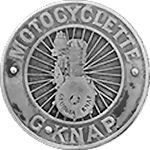



A Brief History of the Marque
Manufactured by Marie-Georges-Henri Knap, 70 rue de Preize, Troyes (1901)
He built his first three-wheeled machines in Belgium under the name "Knap" before moving back to Troyes.
Models include:
Period advertising claims that 400 machines were sold in 1902.
Max Taillefer in "La vie merveilleuse de Georgia Knap" writes:
December 1901 Paris Salon
§ 6. - Ordinary motorcycles.
We can also use a Knap motor, 6 kg and a half, normally 2,400 revolutions per minute and directly driving, by a pinion and a gear wheel, the hub of the rear wheel, near which it is mounted vertically. A bag-tank is placed on the upper side of the frame. The bicycle, which weighs 14.8 kg with brake and freewheel, does not exceed, in running order, the weight of 28 kg. Five minutes is enough to remove the engine and its accessories.
§ 6. - Bicyclettes ordinaires à moteur.
On peut aussi employer un moteur Knap, de 6 kg et demi, faisant normalement 2.400 tours à la minute et attaquant directement, par un pignon et une roue dentés, le moyeu de la roue arrière, près duquel il est monté verticalement. Une sacoche-réservoir est placée sur le côté supérieur du cadre. La bicyclette, qui pèse 14,8 kg avec frein et roue libre, ne dépasse pas, en ordre de marche, le poids de 28 kg. Cinq minutes suffisent pour la débarrasser du moteur et de ses accessoires.
Denis Blaizot in Gloubik Science
GEORGIA KNAP, Troyes, shows the "Knap" gear-driving motor-bicycle in three powers, ¾, 1¼ and 2 h.p. The principle on which this machine is constructed has been described and illustrated in "M. C." recently. The 1¼ and 2 h.p. machines have duplicate forks and Bowden brakes fitted, and Dunlop tyres on Westwood rims. The light touring machine has the tanks cased over with a canvas cover.
Sources:
Bourdache pp 123, 138, etc.
Guélon Collection
If you have a query about these vintage French machines, please contact us